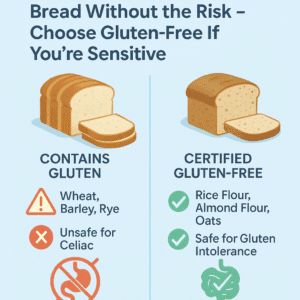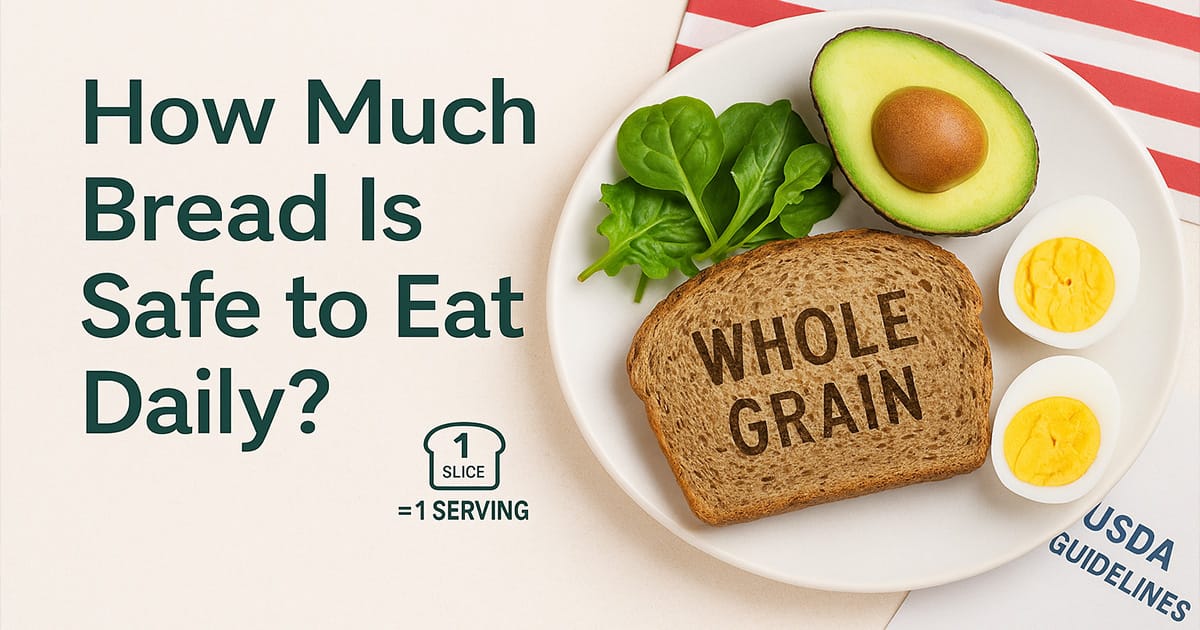How Much Bread Can You Safely Eat Each Day According to U.S. Health Guidelines?
How Much Bread Is Safe to Eat Daily? According to the U.S. Dietary Guidelines, adults are advised to consume 6 to 8 servings of grains per day, with at least half coming from whole grains. Bread, a staple in many households, is one of the easiest ways to meet this recommendation — as long as it’s the right kind of bread.
One slice of bread is usually considered equivalent to one grain portion under dietary guidelines. So if you’re eating 2 slices at breakfast and another 2 at lunch, that’s already 4 servings — perfectly acceptable if your other grain intake is limited. However, the focus shouldn’t just be on how much bread you eat, but also on what kind of bread you’re choosing.
Most white breads are produced using refined flour, which has much of the grain’s natural fiber and nutrients removed during processing. These breads are often less filling and may contribute to rapid spikes in blood sugar.
In comparison, breads made with whole or multigrain flours are more beneficial — they help regulate digestion, provide sustained energy, and offer more vitamins and minerals. To get the best value, choose products labeled “100% whole grain” or “whole wheat” on the packaging.
Also, always check nutrition labels to avoid breads with added sugars, excessive sodium, or preservatives. Portion control, combined with better quality choices, makes bread a safe option even for daily consumption.
So, to answer the question clearly — How Much Bread Is Safe to Eat Daily? If you stick to 3–4 slices of whole grain bread and balance it with other healthy grains, you’re well within a safe and nutritious limit.
Is It Healthy to Eat Bread Every Day? Here’s What U.S. Guidelines Say
1 slice of bread = 1 serving of grain; so 3–4 slices per day can easily fit into a balanced diet, especially if you’re not consuming many other grain-based foods like rice, pasta, or cereal. According to U.S. Dietary Guidelines, adults should aim for 6 to 8 servings of grains daily, with at least half coming from whole grains.
This means you can enjoy a few slices of bread each day — as long as you make healthy choices. Whole grain or whole wheat bread is a much better option than white bread, as it contains more fiber, vitamins, and nutrients. It also helps keep you full for longer and supports better digestion. Just be mindful of added sugars and preservatives in packaged breads. In moderation and with the right type, bread can be a nutritious part of your daily meals without affecting your overall health goals.
Whole Grain vs. White Bread: Why the Right Choice Matters
Whole grain and multigrain breads are often seen as smarter options compared to white bread because they deliver more fiber, essential nutrients, and plant-based compounds that benefit your health. White bread usually contains refined flour that has been stripped of key grain parts during processing, which reduces its overall nutrient content.


On the other hand, breads made with whole grains maintain the bran, germ, and endosperm — the three core parts of the grain — offering a rich source of vitamins, minerals, and antioxidants. These components support long-term health and improve overall dietary quality.
Fiber in whole grains helps with digestion, balances blood sugar, and keeps you full for longer — an advantage for those trying to manage weight. Multigrain options, especially those that use whole ingredients like oats, barley, or millet, offer even more variety in nutrition.
Always read labels for terms like “100% whole grain” or “whole wheat” to ensure you’re making the most nutritious choice. And when planning your meals, it’s important to consider not just the type of bread, but also how much bread is safe to eat daily.
The Risks of Eating Too Much Bread — Especially Refined Varieties
Consuming too much bread, especially white or highly processed types, can have negative effects on your health. These varieties are often low in fiber and digest quickly, causing rapid spikes in blood sugar. Over time, this may increase the risk of weight gain, insulin resistance, and even type 2 diabetes. Processed breads also tend to be high in added sugars and low in essential nutrients, making them less ideal for everyday consumption. Whole grain alternatives are a better choice, offering more fiber, vitamins, and slower digestion. To avoid potential health risks, it’s important to understand how much bread is safe to eat daily, and to make smarter choices when selecting what kind to include in your meals.
Gluten Sensitivity and Bread: What You Need to Know
Individuals with gluten intolerance or celiac disease need to be especially cautious when it comes to bread consumption. Regular bread made from wheat, barley, or rye contains gluten — a protein that can trigger serious health issues in sensitive individuals. For those with celiac disease, even a small amount of gluten can damage the small intestine, leading to poor nutrient absorption, digestive problems, and long-term complications. That’s why it’s crucial to choose certified gluten-free alternatives, which are made from ingredients like rice, almond flour, or oats processed in gluten-free facilities.


These alternatives can provide the satisfaction of eating bread without the health risks. For those managing gluten sensitivity, monitoring intake is essential — not just the type, but also the quantity. Understanding how much bread is safe to eat daily becomes even more important for maintaining digestive health and avoiding symptoms. For personalized advice, it’s best to speak with a doctor or registered dietitian who understands your specific health needs.
Balance is Key: Smarter Bread Pairings for Better Blood Sugar Control
Pairing bread with protein and fiber-rich foods can help stabilize blood sugar levels and reduce its glycemic impact. When eaten alone, especially white or refined bread, it can cause rapid spikes in blood glucose. However, combining it with foods like eggs, nut butter, avocado, or leafy greens slows down digestion and leads to a steadier release of energy. This approach not only helps with blood sugar control but also keeps you feeling full longer, reducing the urge to overeat. For those managing diabetes or watching their carb intake, mindful combinations make a big difference in how your body processes bread.
Expert Guidelines Support Smarter Bread Choices for Long-Term Health
This guide aligns with recommendations from the USDA and the American Heart Association regarding carbohydrate intake and heart health. Both organizations emphasize the importance of choosing whole grains over refined ones and maintaining portion control to support overall wellness. Understanding how much bread is safe to eat daily can help you make better decisions that protect your heart, regulate blood sugar, and prevent excessive calorie intake. Smart choices today contribute to long-term health benefits tomorrow.
You might also like
- Breaking: Jenna Bush Haircut Goes Viral After Surprise Reveal on Today Show, 2025
- Exciting PS6 News Update: Release Window & Key Features
Join our official WhatsApp Channel RealSource24 for breaking news, trending headlines, and real-time alerts — all in one place!

9 thoughts on “How Much Bread Is Safe to Eat Daily? A Guide Based on U.S. Health Standards 2025”